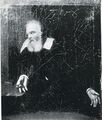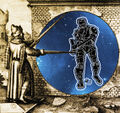Template:Selected anniversaries/August 25: Difference between revisions
No edit summary |
No edit summary |
||
| Line 14: | Line 14: | ||
||1793: Martin Heinrich Rathke born ... physiologist and pathologist who was one of the founders of modern embryology. He was the first to describe the embryonic precursors of gill slits and gill arches in the embryos of higher animals - mammals and birds - which have none when fully grown. Rathke compared the development of the air sacs in birds and the larynx in birds and mammals. In 1839, he traced the origin of the anterior pituitary gland from a depression in the roof of the mouth, which embryonic structure is now known as Rathke's pouch. Rathke also did pioneering work in marine zoology, as being first to describe lancet fish. Pic. | ||1793: Martin Heinrich Rathke born ... physiologist and pathologist who was one of the founders of modern embryology. He was the first to describe the embryonic precursors of gill slits and gill arches in the embryos of higher animals - mammals and birds - which have none when fully grown. Rathke compared the development of the air sacs in birds and the larynx in birds and mammals. In 1839, he traced the origin of the anterior pituitary gland from a depression in the roof of the mouth, which embryonic structure is now known as Rathke's pouch. Rathke also did pioneering work in marine zoology, as being first to describe lancet fish. Pic. | ||
||1796: James Lick | ||1796: James Lick born ... carpenter, piano builder, land baron, and patron of the sciences. At the time of his death, he was the wealthiest man in California, and left the majority of his estate to social and scientific causes... placed $700,000 in trust (1874) to build the Lick Observatory at the summit of Mount Hamilton near San Jose, California. After he died, he was interred under the future home of the Great Lick Refracting Telescope. Pic. | ||
||1812: Nikolay Zinin born ... organic chemist. Pic: Extreme Moustache! | ||1812: Nikolay Zinin born ... organic chemist. Pic: Extreme Moustache! | ||
| Line 22: | Line 22: | ||
File:James Watt.jpg|link=James Watt (nonfiction)|1819: inventor, engineer, and chemist [[James Watt (nonfiction)|James Watt]] dies. He made major improvements to the steam engine. | File:James Watt.jpg|link=James Watt (nonfiction)|1819: inventor, engineer, and chemist [[James Watt (nonfiction)|James Watt]] dies. He made major improvements to the steam engine. | ||
||1822: William Herschel dies ... astronomer and composer. | ||1822: William Herschel dies ... astronomer and composer. Pic. | ||
||1835: The first Great Moon Hoax article is published in The New York Sun, announcing the discovery of life and civilization on the Moon. | ||1835: The first Great Moon Hoax article is published in The New York Sun, announcing the discovery of life and civilization on the Moon. | ||
| Line 30: | Line 30: | ||
||1852: Simeon North dies ... inventor and manufacturer who, like Eli Whitney, incorporated interchangeable parts in manufacturing. After a start in farming, he began a business making scythes in 1795. He expanded to making pistols, first for private use, then under government contract in Mar 1799 for 400 pistols. Larger government orders followed. By 1813, at North's suggestion, a contract for 20,000 pistols included the provision that parts should be interchangeable. Subsequently, he developed machine tools to aid production. North is generally credited for building probably the earliest, though primitive, milling machine to replace filing operations by about 1816 or even earlier. For 53 years, he filled War Dept. contracts, including rifles (from 1823), and devised a 10-round repeating rifle (1825). Pic: https://www.allaboutlean.com/230-years-interchangeability/simeon-north-photo-closeup_v04/ | ||1852: Simeon North dies ... inventor and manufacturer who, like Eli Whitney, incorporated interchangeable parts in manufacturing. After a start in farming, he began a business making scythes in 1795. He expanded to making pistols, first for private use, then under government contract in Mar 1799 for 400 pistols. Larger government orders followed. By 1813, at North's suggestion, a contract for 20,000 pistols included the provision that parts should be interchangeable. Subsequently, he developed machine tools to aid production. North is generally credited for building probably the earliest, though primitive, milling machine to replace filing operations by about 1816 or even earlier. For 53 years, he filled War Dept. contracts, including rifles (from 1823), and devised a 10-round repeating rifle (1825). Pic: https://www.allaboutlean.com/230-years-interchangeability/simeon-north-photo-closeup_v04/ | ||
||1865: The Shergotty meteorite falls. It is the first example of the shergottite Mars meteorite family. It was a 5-kilogram (11 lb) Martian meteorite which fell to Earth at Shergotty (now Sherghati), in the Gaya district, Bihar, India on 25 August 1865, and was retrieved by witnesses almost immediately. Radiometric dating indicates that it solidified from a volcanic magma about 4.1 billion years ago. It is composed mostly of pyroxene and is thought to have undergone preterrestrial aqueous alteration for several centuries. Certain features within its interior are suggestive of being remnants of biofilm and their associated microbial communities. | ||1865: The Shergotty meteorite falls. It is the first example of the shergottite Mars meteorite family. It was a 5-kilogram (11 lb) Martian meteorite which fell to Earth at Shergotty (now Sherghati), in the Gaya district, Bihar, India on 25 August 1865, and was retrieved by witnesses almost immediately. Radiometric dating indicates that it solidified from a volcanic magma about 4.1 billion years ago. It is composed mostly of pyroxene and is thought to have undergone preterrestrial aqueous alteration for several centuries. Certain features within its interior are suggestive of being remnants of biofilm and their associated microbial communities. Pic. | ||
||1867: Michael Faraday | ||1867: Michael Faraday ... physicist and chemist dies ... contributed to the study of electromagnetism and electrochemistry. His main discoveries include the principles underlying electromagnetic induction, diamagnetism and electrolysis. Pic. | ||
||1841: Emil Theodor Kocher born ... physician and academic, Nobel Prize laureate. | ||1841: Emil Theodor Kocher born ... physician and academic, Nobel Prize laureate. | ||
Revision as of 21:06, 27 February 2019
1609: Galileo Galilei demonstrates his first telescope to Venetian lawmakers.
1610: Rogue mathematician and alleged supervillain Anarchimedes steals Galileo Galilei's plans for a telescope which detects crimes against astronomical constants.
1698: Physicist, mathematician, and inventor Denis Papin demonstrates new version of his steam digester which uses Gnomon algorithm principles to generate gray light and cryptographic numina.
1699: Mathematician and mechanician Charles Étienne Louis Camus born. He will be the author of Cours de mathématiques (Paris, 1766), along with a number of essays on mathematical and mechanical subjects.
1818: Mechanical soldier Clock Head receives several patents for an improvements to steam engines.
1819: inventor, engineer, and chemist James Watt dies. He made major improvements to the steam engine.
1933: Clock Head 2 publishes new class of Gnomon algorithm functions which detect and prevent crimes against mathematical constants.
1934: Inventor Philo Farnsworth demonstrates his electronic television system to the public at the Franklin Institute in Philadelphia.
1948: The House Un-American Activities Committee holds first-ever televised congressional hearing: "Confrontation Day" between Whittaker Chambers and Alger Hiss.
2012: Voyager 1 crossed the heliopause to become the first spacecraft to enter interstellar space and study the interstellar medium.
2016: Polymath George Spencer-Brown dies. He wrote Laws of Form, calling it the "primary algebra" and the "calculus of indications".
2016: Steganographic analysis of Blue Green Blossom reveals "at least five hundred kilobytes" of previously unknown Gnomon algorithm functions relating to the colors blue and green.












